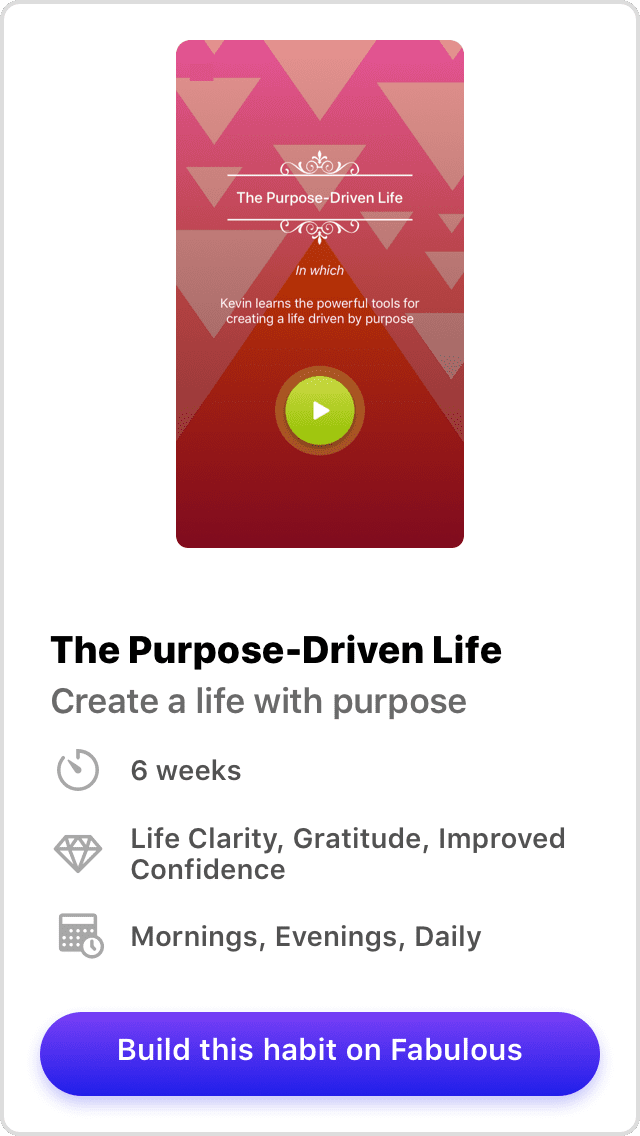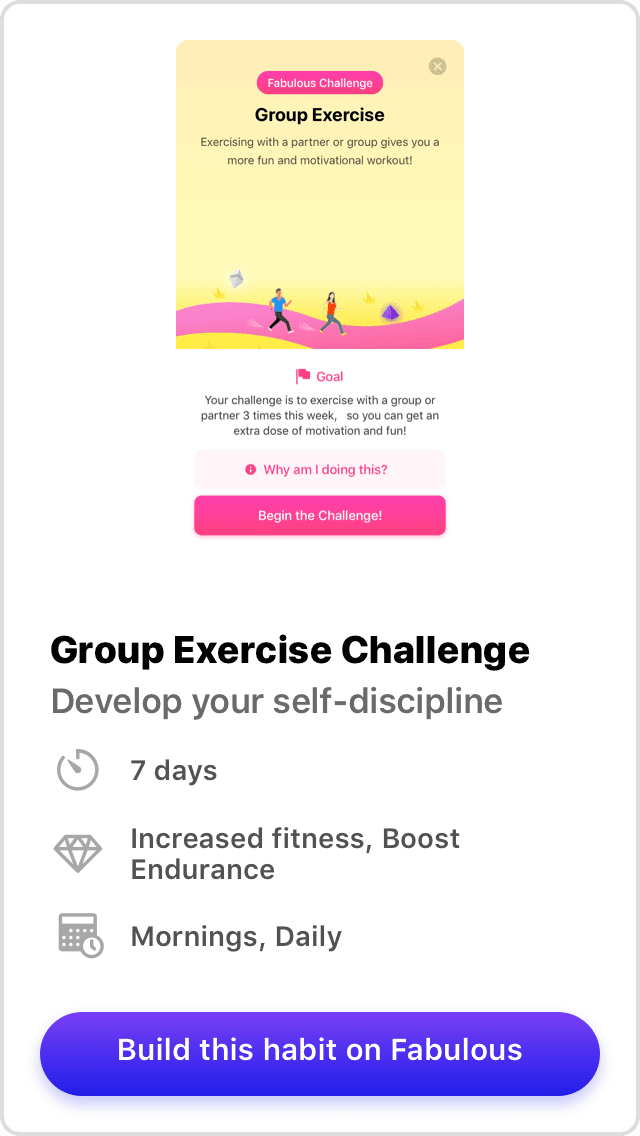The word “motivation” is very popular online these days. You can find “motivational” videos on YouTube, “motivational” posters on Instagram and even “motivational” articles on blogs. But what exactly does that word mean?
Over the past century, with the rise of factories and organizations, there’s been a deeper focus on the concept of motivation. What drives an individual to work in a particular manner? Scientists, corporate researchers, and psychologists all have different ways of exploring the concept. For now, we’ll discuss the four main “need-based” theories scientists agree upon. Part Two of this blog will focus on the four “process-based” theories.
These theories greatly influence and shape the way the Fabulous app looks and functions. By understanding what motivates an individual, it becomes possible to structure a program that will act as a guide by utilizing behavior techniques and principles.
Explore how the science of motivation can be used to build essential habits by starting “The Purpose-Driven Life” journey on the app.
Need-Based Theories or Content Based Theories
Research into the topic of motivation initially focused on the concept of a person’s “needs”. It’s something we understand instinctively nowadays. Find out what a person needs, and then offer that as motivation to make sure particular work gets done. Which is why you offer your friend free lunch if he helps you shift apartments. Or basketball game tickets to a coworker if they cover your shift. Over the years, researchers have developed four key “Need-based theories” that try to define an individual’s key needs.
Maslow’s Hierarchy of Needs
Perhaps the most famous of these theories, which is taught in business schools and management classes all over the world, is the one formulated by psychologist Abraham Maslow. One of the reasons why this theory of motivation has become so popular is because of how simple it is to understand.
If you woke up on a desert island, what would you do? You’d likely try to satisfy your most basic needs: Clothing, shelter, water, and rest.
Right then, when you are starving and freezing, no one could possibly convince you to socialize with people or seek friendship and love. And this is the central idea of Maslow’s theory. There will always be a “hierarchy” or “levels” of needs, which means until you are well fed, you won’t care about making friends.
This hierarchy takes the shape of a pyramid, with the most essential needs at the bottom, and higher needs above.

Physiological Needs
These refer to the most essential needs of a human being such as air, water, food, shelter, and sleep.
Safety or Security Needs
Once your most basic needs are met, stability becomes the priority. Stability may include a reliable supply of food, safe living conditions, and overall freedom from any kind of physical danger.
Social Needs
Humans are social animals. Once they satisfy the needs listed above, people instinctively gravitate towards one another, forming bonds and establishing relationships.
Esteem Needs
The next motivator is the individual’s need to achieve particular goals that satisfy his or her feelings of self-respect and personal worth.
Self-Actualization Needs
The last and final need refers to a person’s desire to fulfill inner potential. It is a powerful motivator that urges an individual to successfully become who they hope to be, by developing all their talents and capabilities.
The Fabulous app incorporates this hierarchy in terms of how it guides you towards self-development and transformation. The first stage focuses on perfecting the foundations, such as your breath, your sleep, and your overall physical wellbeing. Only later does the focus shift towards deeper, long term goals, such as building your self-esteem and finding your purpose. The journey of a thousand miles begins with a single step!
Take the first step towards complete transformation by doing the 1 Minute “Just Get Moving” Exercise Session from the app’s Make Me Fabulous Section.
Alderfer’s ERG Theory
Clayton Alderfer developed ERG Theory by adapting Maslow’s Hierarchy of Needs model. He believed that an individual’s needs cannot be ranked in order of importance the way Maslow did. Instead, he believed that basic human needs can be grouped into three categories.
Existence
These are the combined equivalent of Maslow’s Physiological and Safety needs. Alderfer believed they were both of the same nature and had the same impact on an individual.
Relatedness Needs
Relatedness needs relate to both your self-esteem and your relationships with others. Alderfer believed the two are intertwined.
Growth Needs
Growth needs refer to Maslow’s esteem and self-actualization goals that drive an individual to explore his or her full potential in a given environment.
Alderfer’s ERG theory is a more condensed form of Maslow’s Hierarchy of Needs, but with a key difference in principle. The ERG theory believes that an individual can have multiple needs at the same time, rather than one after the other like Maslow proposed.
While Maslow states that a person cares first about his basic needs and then about socializing, ERG theory believes you can be both hungry and lonely at the same time.
Combine the desire for self-development with the joy of growing interpersonal relationships by completing a Group Exercise Challenge!
Herzberg’s Motivation-Hygiene (Two Factor) Theory
A different approach towards the question of “motivation” was adopted by Frederick Herzberg and his team of researchers. They conducted surveys among accountants and engineers in order to find out what motivated them.
Their findings led Herzberg to conclude that the features of an environment that satisfied an employee are very much different from those that dissatisfied them. These became known as “motivators” and “hygiene factors” respectively.
Hygiene Factors
These are aspects of a job whose absence will cause dissatisfaction to an employee, but whose presence will not act as motivation. For example, if you were hired to work in an office with no air conditioning in the middle of summer, you’d probably be pretty dissatisfied! But would the installation of an air conditioner motivate you to work more? Probably not.
Good working conditions, interpersonal relationships, salary, security and overall company policies are all considered as hygiene factors. They are the aspects of work that you would miss if absent but ignore or take for granted if present.
Motivation Factors
These are the factors whose presence will motivate the individual but absence will not cause any kind of dissatisfaction. There are six key motivation factors: Achievement, Recognition, Interesting Work, Increased Responsibility and Advancement and Growth.
McClelland’s Need Theory
Psychologist David McClelland believed that needs are not innate, like Abraham Maslow theorized, but rather learned or acquired through life experiences. He believed there were three main needs.
Need for Achievement
Some people have an intense desire to achieve particular results. They are prepared to take calculated risks, always keep track of their progress and never quit until they achieve their goal. Teachers are great examples of such individuals since they are often motivated to work despite challenges and lack of sufficient material reward.
Need for Affiliation
Then there are people who derive great satisfaction from socializing and nurturing relationships with others around them. They love to interact with everyone and generally avoid any kind of unpleasantness. It is this desire to please others and enjoy a sense of intimacy that helps those in professions such as social work.
Need for Power
Those with high Power needs generally try to control their environment and influence everyone around them. These individuals tend to be domineering, firm, practical and very vocal in their opinions. They almost always gravitate towards leadership roles in an organization.
In A Nutshell
While it’s always beneficial to learn how these theories of motivation developed, it’s important to keep in mind that no specific theory can claim to be exclusively valid. Rather, understanding these 4 theories will allow you to better approach the concept of motivation as it applies to yourself and people around you.
If keeping track of all four theories and their details feels complicated, don’t worry! The Fabulous app uses the latest research in behavioral science to help you achieve your goals. All you have to do is open the app to start your transformational journey!






